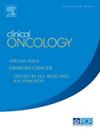Clinical Outcomes and Relevance of Composite V12 Gy in Patients With Four or More Brain Metastases Treated With Single Fraction Stereotactic Radiosurgery
IF 3.2
3区 医学
Q2 ONCOLOGY
引用次数: 0
Abstract
Aims
Tissue V12Gy (total brain volume receiving 12Gy including target) can predict for late toxicity in single target benign disease treated with stereotactic radiosurgery (SRS). The value of this metric remains uncertain for multiple brain metastases. This retrospective cohort study reports the outcomes and evaluates the predictors of toxicity in patients with four or more brain metastases treated with single-fraction SRS.
Materials and methods
Two hundred twenty-six patients with 2160 metastases treated from 2014-21 were retrospectively studied. Symptomatic late toxicity (new/progressive neurological symptoms ≥3 months post SRS) with magnetic resonance imaging (MRI) changes suggestive of treatment effect were analysed. Kaplan–Meier and competing risk analysis was used to assess survival and toxicity respectively.
Results
median number of metastases/patient was 6 (range: 4-41) and median composite tissue V12Gy (inclusive of planning target volume (PTV)) was 11.3 cc (IQR: 6.1 cc–17.1 cc). Sixteen out of the 226 patients developed symptomatic late radiation adverse event (R-AE), and the cumulative incidence was 4.9% at 1 year and 6.9% at 2 years. The total target volume was significantly predictive of the risk of late R-AE. Volume of the largest lesion, V12Gy and V15Gy did not predict for late R-AE, but plotted graphs showed suggestions of linear relationships between dosimetric parameters and late R-AE.
Conclusion
Within the limitations of this study, the cumulative incidence of symptomatic toxicity remains acceptable despite routinely accepting a composite tissue V12Gy in excess of 10 cc to treat multiple brain metastases.
Advances in knowledge
V12Gy has limitations as a plan quality metric in multiple brain metastases treated with SRS. There is insufficient evidence to have a defined target limit as <10 cc.
单分次立体定向放射手术治疗四个或四个以上脑转移灶患者的临床疗效及复合 V12 Gy 的相关性。
目的:组织 V12Gy(接受 12Gy 放射线(包括靶点)的脑部总体积)可预测立体定向放射手术(SRS)治疗单个靶点良性疾病的后期毒性。但这一指标对于多发性脑转移瘤的价值仍不确定。这项回顾性队列研究报告了采用单分量SRS治疗四个或四个以上脑转移瘤患者的结果,并评估了毒性的预测因素:回顾性研究了2014-21年间接受治疗的226例2160例转移瘤患者。分析了有症状的晚期毒性(SRS后≥3个月出现新的/进展性神经症状)和提示治疗效果的磁共振成像(MRI)变化。结果:中位转移灶数量/患者为 6 个(范围:4-41),中位复合组织 V12Gy(包括规划靶体积(PTV))为 11.3 cc(IQR:6.1 cc-17.1 cc)。226 例患者中有 16 例出现了无症状的晚期放射不良事件 (R-AE),1 年和 2 年的累积发生率分别为 4.9% 和 6.9%。总靶体积对晚期 R-AE 的风险有明显的预测作用。最大病灶体积、V12Gy和V15Gy不能预测晚期R-AE,但绘制的图表显示剂量参数与晚期R-AE之间存在线性关系:结论:在本研究的局限性范围内,尽管常规接受超过 10 cc 的复合组织 V12Gy 治疗多发性脑转移瘤,但症状性毒性的累积发生率仍然是可以接受的:V12Gy作为SRS治疗多发性脑转移的计划质量指标具有局限性。目前还没有足够的证据来确定一个明确的目标限值。
本文章由计算机程序翻译,如有差异,请以英文原文为准。
求助全文
约1分钟内获得全文
求助全文
来源期刊

Clinical oncology
医学-肿瘤学
CiteScore
5.20
自引率
8.80%
发文量
332
审稿时长
40 days
期刊介绍:
Clinical Oncology is an International cancer journal covering all aspects of the clinical management of cancer patients, reflecting a multidisciplinary approach to therapy. Papers, editorials and reviews are published on all types of malignant disease embracing, pathology, diagnosis and treatment, including radiotherapy, chemotherapy, surgery, combined modality treatment and palliative care. Research and review papers covering epidemiology, radiobiology, radiation physics, tumour biology, and immunology are also published, together with letters to the editor, case reports and book reviews.
 求助内容:
求助内容: 应助结果提醒方式:
应助结果提醒方式:


